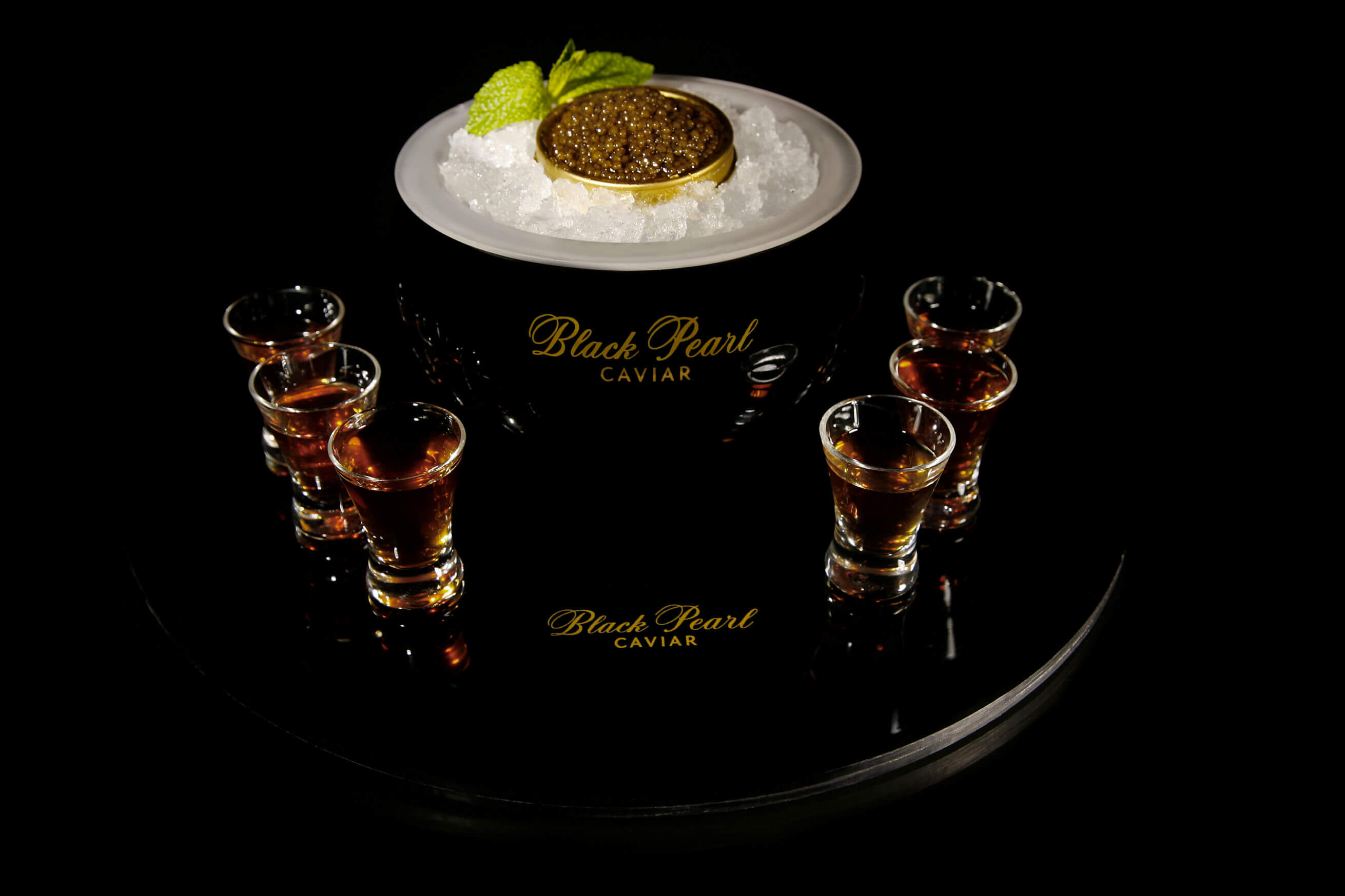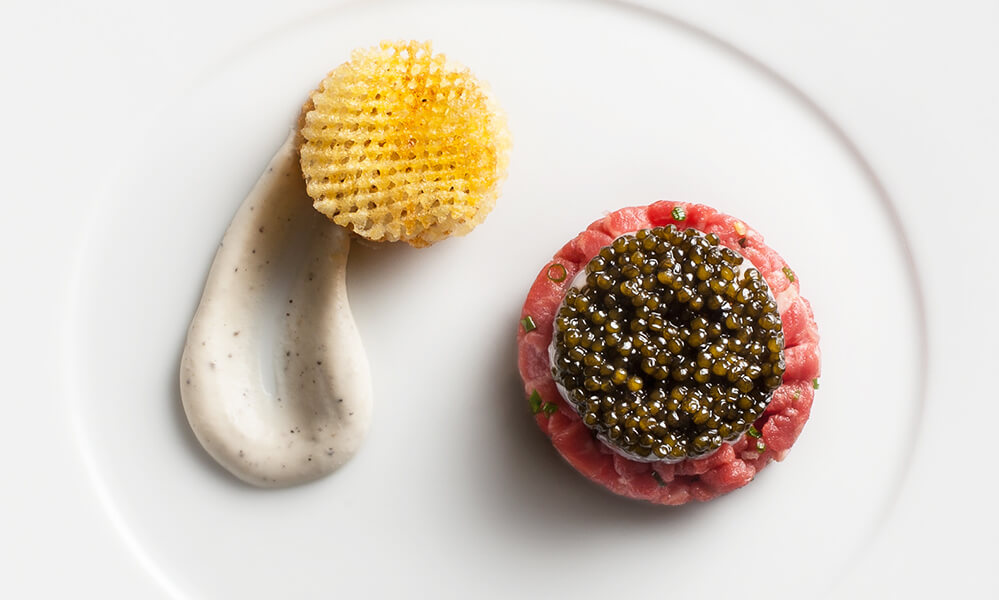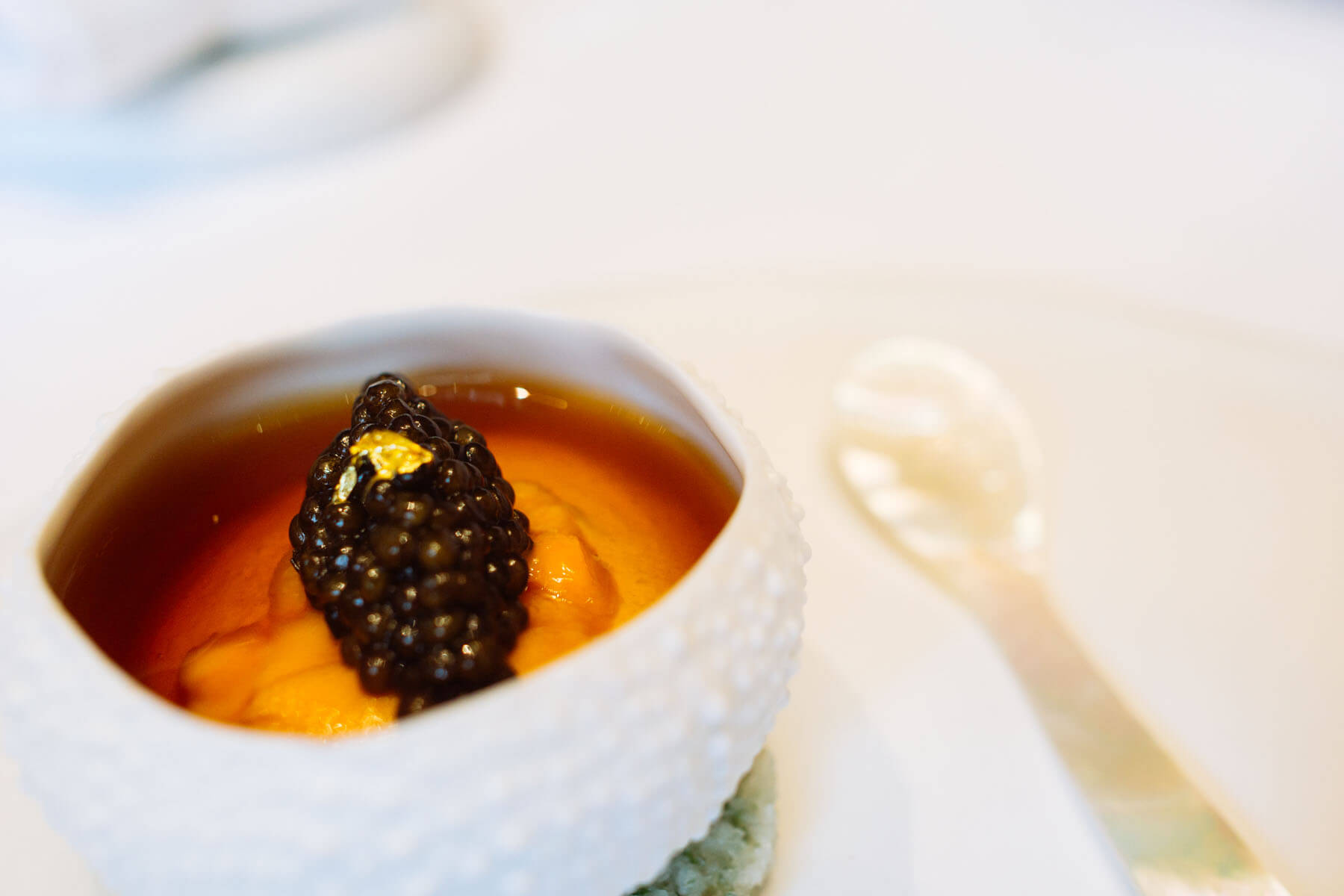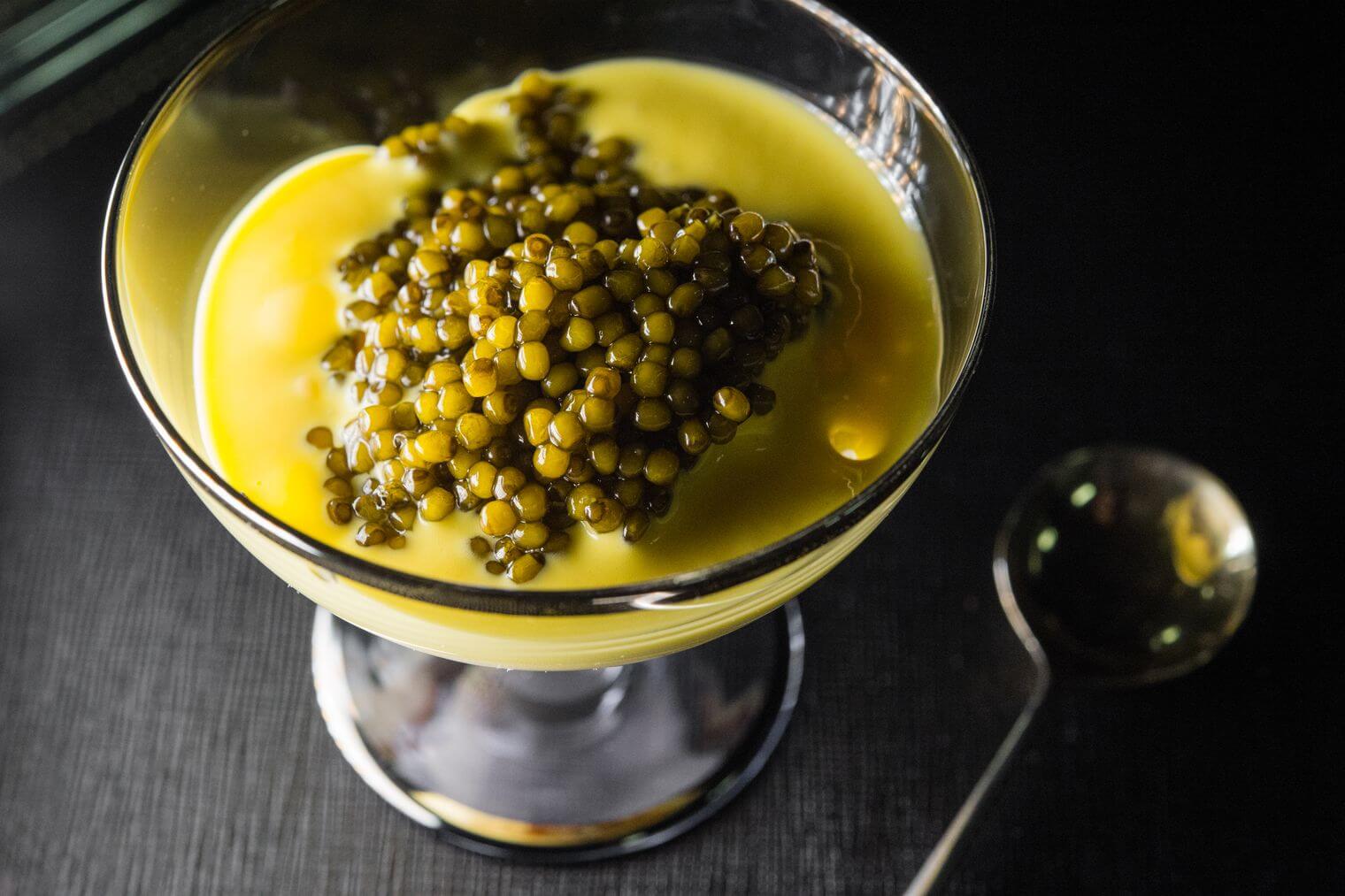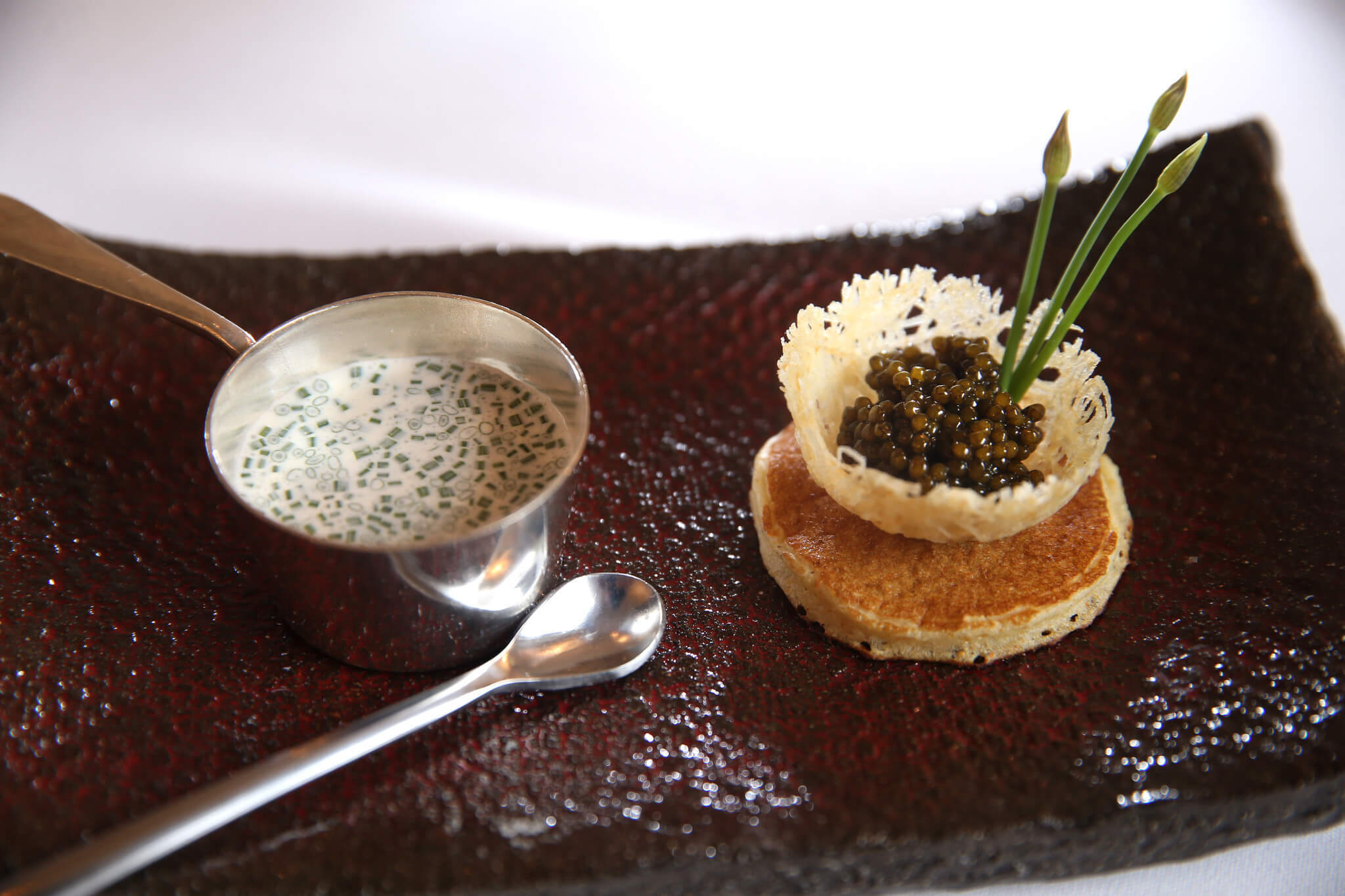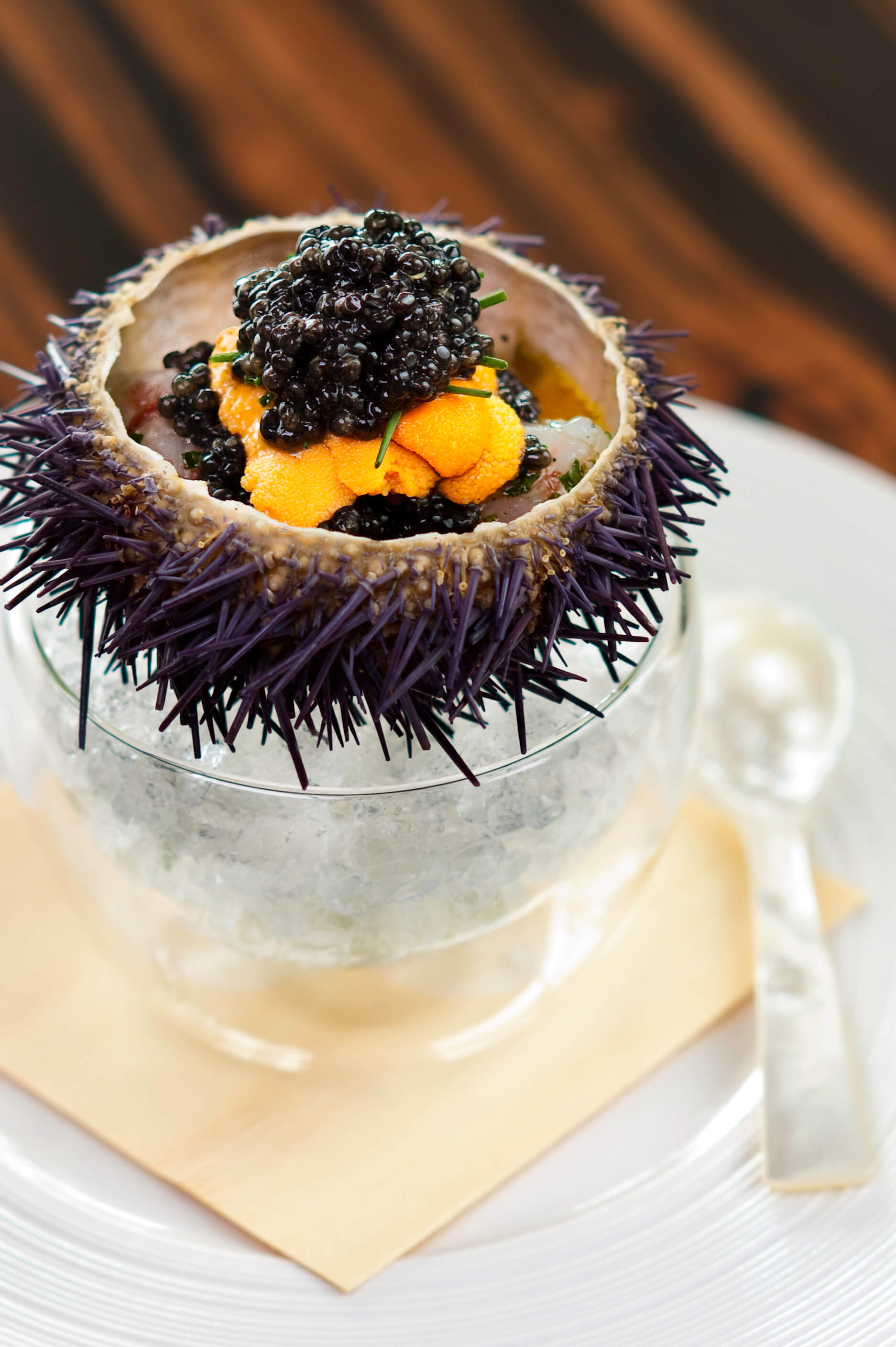Where does caviar come from?
If you’re interested in luxury food products, then you’ve likely come across many different types of caviar on the market, from the rich high-end varieties to cheap imitations. But when it comes to understanding the sources of your food, where exactly does the world’s most luxurious, aromatic and delectable caviar come from and where is the caviar sourced?
We will take a closer look at the source of this rich food, as well as the habitats of the animals that produce it. Discover where the best caviar comes from, and the ways that farming can make all the difference to the quality of the final product.
The sources of where caviar originates
When it comes to the production of caviar, there are only a few key places in the world where caviar truly comes from. While Iran produces the most exceptional and flavour-filled caviar that money can buy, farms in Europe also are a huge source of knock-offs. These poorly run farms pump the fish with hormones and supplements so that the animals can survive the harsh industrial-sized tanks where profit and speed are the only priorities.
It takes meticulous precision to create the optimal environment for the production of truly delightful caviar. The sturgeon-rearing process should be administered and tested in accordance with the latest technologies. Highly qualified technical staff and demanding quality controls are vitally important. Caspian Monarque complies with all requirements thus overseeing every single step of the process and every aspect of rearing.
Persian Osetra
Osetra caviar is the second-most expense type in the world. It is sourced from the Iranian sturgeon (Acipenser gueldenstaedtii) and is found only in the Caspian Sea. Our farm actually has a sealed-off area within the Sea where our fish (and thus the caviar) can flourish in their natural habitat. Caspian Monarque raises sturgeon exclusively in this manner.
The Osetra is an anadromous fish (i.e. migrates from salt-water to fresh water to spawn). It grows to over 2 meters in length. Fecundity ranges between 70,000 to 800,000 eggs. The colour of the eggs does vary significantly. For example, blackish, large eggs may be marketed falsely as Beluga. Therefore, one cannot rely on this to determine if caviar is fake (click here for more information). The species is the single most important commercial source of sturgeon (and therefore caviar) in the world. The stocks in the Caspian Sea are kept replenished by a massive artificial propagation program run by the Iranian government who have been widely praised for this.
Iranian Beluga and Almas Caviar
The country of Iran, located alongside the mythical and fertile Caspian Sea, is the source of some of the most refined and pristine caviar in the world and is the home of the beluga sturgeon.
These rare fish are organically and sustainably farmed on the Iranian coastal waters of the Caspian Sea, producing the most sought-after and expensive type of caviar in the world: beluga caviar.
In fact, according to renowned chefs, including Gordon Ramsay in his book ‘A chef for all seasons,’ Iranian caviar is a step above anything else on the market, in part thanks to the excellent diet of the fish, and the unmatched quality of water of their natural habitat. While Russian-sourced osetra caviar could still be considered a luxury, it’s nowhere near the standards of the caviar found in Iran.
The fish roe harvested in these sustainable farms by brands such as Caspian Monarque is intensely sought-after due to the more natural way the fish are bred and managed. The Caspian Sea itself provides unparalleled benefits and a superior environment to these more organically-bred fish, further improving the final, luxurious result: caviar with the best texture and taste profile in the world.
The families; species of sturgeon and caviar
There are two families of fish which provide the blackish coloured eggs prized for caviar, listed below:
- Sturgeons (Acipenseridae) have four genera:
- Belugas (Huso)
- Sturgeons (Acipenser)
- Shovel-nosed sturgeons (Scaphirhynchus)
- False shovel-nosed sturgeons (Pseudoscaphirhynchus)
- Paddlefish (Polyodontidae) have two genera, each with a single living species:
- Mississippi basin paddlefish (Polyodon spathula)
- Yangtze River paddlefish or Chinese swordfish (Psephurus glodius)
Figure 1.3 shows historical areas of sturgeon distribution in the northern hemisphere (there are no natural populations of sturgeons in the southern hemisphere). Note that the present commercial range of these species is in all cases severely restricted. A number of sturgeon species are reduced to very small populations and in some cases are close to extinction.
Table 2.1 is a compilation by Dr. V. Sternin of data concerning record sturgeons reported over the centuries. Although the 4,000 kilogram (9,000 pound) beluga mentioned cannot be verified, the Astrakhan Museum exposition has on display the 1,000 kilogram (2,156 pound) example captured in the Volga River as recently as 1989 (see Figure 2.1).
Nomenclature To learn more about the definitions involved, please consult our caviar glossary
Table 2.2 shows all currently recognized species of the two aforementioned families (not including subspecies), together with the English names preferred by the American Fisheries Society (AFS) for use in North America (in Common and Scientific Names of Fishes from the United States and Canada, 5th Edition, 1991; and World Fishes Important to North Americans, 1991). In the column headed “Other Names” are listed the common names often used for these species. Note that in the USA, vernacular names of fish species used in commerce have been codified by the U.S. Food and Drug Administration in a 1988 publication called “The Fish List: FDA Guide to Acceptable Market Names for Food Fish Sold in Interstate Commerce”. In general, the FDA follows the lead of the AFS. In the case of sturgeon, however, both bodies have ignored common commercial usage for certain species. As these names are in no way confusing or misleading, we have listed them in bold face type in Table 2.2, to indicate that in the opinion of the authors, these highlighted names are the ones which would be best to use.
In particular, Acipenser stellatus is called “stellate sturgeon” by AFS and “star sturgeon” by FDA; but in the marketplace, caviar from this important species is always known as sevruga.
Acipenser nudiventris is more commonly known as ship than as thorn.
Acipenser gueldenstaedti, called Persian sturgeon by AFS and FDA, is most commonly known as osetra. Most confusing, perhaps, is that FDA calls the beluga (Huso huso) European sturgeon, the name more accurately given by AFS to Acipenser sturio.
These FDA lacunae are unfortunate, since beluga, sevruga and osetra are among the most important sturgeon that are used commercially for caviar and the names have long and honourable histories. The Iranian names cannot be confused with the names of any other fish and are familiar to people interested in caviar.
Traditionally, the tins of caviar have different colours (blue, yellow and red) depending on several factors. These will be explained in the description of each species in the sections that follow.
Beluga. Both beluga (Huso) and sturgeons (Acipenser) include freshwater and migratory saltwater species. All of them spawn in freshwater. The most obvious physical features are the five rows of bony scutes along the body. One row runs along the centre of the back. Two rows run along the lateral line and turn upwards towards the tail. Two rows on the belly merge into a central row behind the vent. Their bodies are elongated and sub-cylindrical. The snouts are elongated with two pairs of barbels between the tip and the mouth. Females are larger than males.
The genus of the beluga (called the Great Sturgeon by the Persians) consists of two species: beluga (Husohuso) and kaluga(H. dauricus) (or the Great Siberian sturgeon). Beluga (figure 2.2) inhabits the Caspian, Black, Azov and eastern part of the Mediterranean seas. It is one of the largest fishes, which may live more than a hundred years, and grow to more than 5 meters (16 feet) long. The fish mature for the first time at the age of 12 to 18 years and then migrate upstream to spawn. The major historic spawning rivers are the Volga, Ural, Kura, Kuban, Don, Terek, Dnestr, Desna, Dnepr, Bug, Ryoni, Danube (up to Bratislava) and the River Po.
Beluga migrate in the spring and the fall. Fecundity ranges between 200,000 to 3 million eggs; the record is thought to be as many as 8 million. After its first maturation, the female does not become gravid again for another seven years. Belugas feed mainly on small fish, but baby seals have been found in the stomachs of the largest specimens.
Three subspecies with minor distinguishing characteristics are reported:
- Husohusoorientalis, in the Black Sea
- Husohusomaeoticus in the Sea of Azov
- Husohusocaspicus in the Caspian Sea
| Table 2.2 Scientific and common names of sturgeon and paddlefish species |
||
| Species | American Fisheries Society name | Other names |
| Acipenser baeri | Siberian sturgeon | |
| Acipenser brevirostrum | Shortnose sturgeon | |
| Acipenser dabryanus | Yangtze sturgeon | |
| Acipenser fulvescens | Lake sturgeon | |
| Acipenser gueldenstaedti | Persian sturgeon | Osetra; Kura sturgeon; Iranian sturgeon |
| Acipenser medirostris | Green sturgeon | Sakhalin sturgeon |
| Acipenser multisculatatus | Japanese sturgeon | |
| Acipenser naccarii | Adriatic sturgeon | Italian sturgeon |
| Acipenser nudiventris | Thorn sturgeon | ship sturgeon; spiny sturgeon |
| Acipenser oxyrhynchus | Atlantic sturgeon | |
| Acipenser ruthenus | Starlet | |
| Acipenser schrencki | Amur sturgeon | |
| Acipenser sinensis (A. kikuchii) | Chinese sturgeon | Sagami sturgeon |
| Acipenser stellatus | Stellate sturgeon | Sevruga; star sturgeon |
| Acipenser sturio | European sturgeon | Baltic sturgeon; common sturgeon, Atlantic sturgeon |
| Acipenser transmontanus | White sturgeon | |
| Huso dauricus | kaluga | Great Siberian sturgeon …continued |
| Table 2.2 Scientific and common names of sturgeon and paddlefish species (continued) |
||
| Species | American Fisheries Society name | Other names |
| Husohuso | Beluga | Hausen |
| H. huso (fem) xA. ruthenus (male) |
Bester; hybrid sturgeon | |
| Polydonspathula | Paddlefish | Mississippi paddlefish |
| Psephurus gladius | Chinese sword-fish | Chinese paddlefish; Yangtze paddlefish |
| Pseudocaphirhynchus fedtschenkoi |
Syr Darya sturgeon | Syr Darya shovelnose sturgeon |
| Pseudocaphirhynchus hermani |
Dwarf sturgeon | little shovelnose sturgeon |
| Pseudocaphirhynchus kaufmanni |
Amu Darya sturgeon | Amu Darya shovelnose sturgeon; big false shovelnose sturgeon; shovelfish. |
| Scaphirhynchusalbus | Pallid sturgeon | |
| Scaphirhynchus | Shovelnose | |
| platorynchus | sturgeon | |
| Sources: American Fisheries Society; Wheeler 1975. | ||
| Note: Bold type indicates preferred name. Subspecies are not included. For details of subspecies, see text. |
||
Sevruga or stellate sturgeon, (Acipenserstellatus) is the third most important species. Its name became a trade name for the smallest, darkest and, in the opinion of some experts, tastiest caviar eggs. Note the comments about its American names at the beginning of this section. The fish is easily distinguishable by its long snout, which constitutes over 60 percent of the head. Between the belly and back scutes there are many light, star-like spots. It grows up to 2.2 meters (5 feet) long, and 80 kg (175 pounds) in weight and lives for about 30 years (figure 2.5). It is an anadromous fish. Fecundity varies from 50,000 to 700,000 eggs, which are 1.2 to 2.5 mm in diameter. The fish is the second most important commercially after osetra, in terms of volumes of meat and caviar. sevruga caviar is packed under the red coloured lid.
Stocks of sevruga are not seriously depleted. The resources are supported by artificial propagation. Sevruga inhabits the Caspian, Black and Azov Sea basins. Its reported presence in the Adriatic Sea is questionable. The main spawning rivers include the Volga, Ural, Kura, Terek, Dnestr, Dnepr, Danube, Ryoni, Don and Kuban.
Osetra or Persian sturgeon(Acipensergueldenstaedti) is only from the basins of the Caspian Seas, where it forms distinct, localized stocks. It is known to have two subspecies: the Persian sturgeon (Acipensergueldenstaedtipersicus) spawning in the Iranian rivers Babol, Gorgan and Safid-Rud and the Russian river Kura; and the Black Sea sturgeon (Acipensergueldenstaedticolchicus).
The Osetra sturgeon is an anadromous fish but occasionally lives permanently in fresh waters. It reaches over 2 meters (7 feet). As do most other sturgeons, it has both spring and fall spawning races. The fall races enter rivers late and spawns the following year. Fecundity ranges between 70,000 to 800,000 eggs. As they grow, the feeding pattern of the fish changes from exclusively invertebrates to a mixed diet which includes small fish. The fish migrate upstream in the following rivers: Volga, Ural, Emba, Kura, Terek and Sulak (all from the Caspian Sea); the Danube (up to Bratislava), Dnestr, Bug, Dnepr, Ryoni (from the Black Sea); Mius, Don, Yeja, Kuban (from the Azov Sea).
This species is the single most important commercial source of sturgeon and caviar in the world. The stocks in the Caspian Sea are kept in sufficiently high by massive artificial propagation by both Russia and Iran. Iran, in particular, has been praised for their efforts (they voluntary joined the international ban) and is still permitted to sell wild caviar.
The eggs of Osetra sturgeon are smaller than beluga eggs, at about 1.5 to 3 mm diameter. The egg colour shades vary considerably. Blackish, large eggs may be marketed as beluga eggs and sealed under the blue colour lids. However, the bulk is sold under the trade name “Osetramalosol” and sealed under the yellow-orange coloured lid.
Paddlefish. The Mississippi paddlefish used to be of considerable commercial value. It grows to 2 meters (6.5 feet) and once occupied the whole of the Mississippi watershed from North Dakota to the Gulf of Mexico and east to New York and South Carolina. Little is known about the Yangtze River paddlefish but the fact that its flesh is highly rated. The species reported to grow a large as 7 meters (23 feet) and is found only in the lower reaches of the Yangtze River.
Shovelnose.Of the two species of shovelnose inhabiting the Mississippi basin, the shovelnose sturgeon (Scaphirhynchus platorhynchus) was once of commercial value The. It is a small (for a sturgeon), reaching about 1 meter (3.5 feet). The other, larger, one (S. albus) is a rarity and is now found only in the lower reaches of the Missouri-Mississippi and Kansas Rivers and their tributaries. The American Fisheries Society calls it “pallid sturgeon”.
False shovelnose sturgeons (Pseudoscaphirhynchus) inhabit the Aral Sea basin. The genus consists of three species. Two species, the big false shovelnose (Pseudoscaphirhynchus kaufmanni) and the small false shovelnose (Pseudoscaphirhynchus herrnanni) live in the Amu-Darya River from the lower reaches to Pyjandzh River. The third one (Pseudoscaphirhynchus fedtschenkoi), a rarity, lives in Syr-Darya River. These species were never of commercial value. Nowadays, with the Aral Sea catastrophically reduced in size, all of these species are doomed for extinction.
Kaluga(Huso dauricus) is a freshwater species of the Amur basin (figure 2.3). (The Amur River forms part of the eastern border between Russia and China.) Kaluga migrate in the river from the estuary area upstream to the tributaries: Ussuri, Sungari, Shilka and Argun. It is found in lakes Chanka and Bolon. It is very similar to and as large as or even larger than the Caspian beluga. Its growth rate is slower. Fecundity is between 600,000 and 4 million eggs. Egg sizes for both beluga and kaluga are 2.5 mm up to 4 mm. Mature eggs may constitute over 25 percent of the female body weight. Adult kaluga is a predator which feeds on large fish including salmon. Both kaluga and beluga are the source of the most valuable, large sized, greyish caviar known under the trade name “Beluga Malosol”, traditionally sealed under blue colour lids.
Sturgeons.The genus Acipenser (sturgeons) has the largest area of habitat and consists of at least 16 species. Species are found in European, Asian and American waters. The Atlantic, European, Baltic or common sturgeon (Acipensersturio) was once found along the European coastline, including the Baltic, northern Mediterranean and Black Seas and the shores of England, Ireland, southern Iceland and the northern coasts of western Africa. It also may inhabit lakes, e.g., Ladoga and Onega. Of all the previously abundant populations — in Varangare Fjord (Norway), Neva River and Ladoga Lake (Russia), Ryoni River (Georgia), the Elbe River (up to Prague), Mosel, Rhine (up to Basel, Switzerland), Gironde (France), Guadalquivir (Spain), Danube (Rumania), Thames (England), Vistula (up to Crakow, Poland) — only the Danube still supports some sturgeon fisheries and a small amount of caviar production.
European, Baltic or Atlantic sturgeon(Acipenser sturio) is an anadromous fish, which spends only a relatively short time in fresh water. It may reach 3 meters (10 feet) in length and 200 kg (440 pounds) in weight (figure 2.4). However, much larger fish have been recorded (see table 2.1). Fecundity ranges from 200,000 to 6 million eggs. This fish feeds mainly on invertebrates, although the diet of adults includes large proportions of small fish.
Ship or thorn sturgeon (Acipenser nudiventris) is another commercially viable species. It differs from other sturgeons by having a continuous lower lip and fringed barbels. It is a fast-growing anadromous fish inhabiting the Aral, Caspian and Black Seas, reaching 2 meters (6.5 feet) in length. Its fecundity ranges from 200,000 to 1.3 million eggs. It feeds mainly on molluscs in the Aral Sea and on small fish in the Caspian. In the Aral basin it used to spawn high upstream in both the Syr-Darya and Amu-Darya Rivers, but it is now almost extinct in these waters. It is not common in the Volga but more abundant in the southern Caspian River Kura. It matures at age 12, lives 30 years and spawns every two to three years. The fish was successfully introduced into Lake Balkhash. It is of some commercial importance but has not served as a trade- or market name for caviar. Depending on the size and colour, the caviar is marketed under the yellow or red colour lids. Ship sturgeon often forms hybrids with sevruga, osetra and beluga.
Sterlet (Acipenser ruthenus) is a freshwater, barely migrating fish. It is relatively small, up to one meter (3.25 feet). This sturgeon matures at the age of five. Its fecundity is between 5,000 and 100,000 eggs; egg size is 1.5 min to 1.9 mm. It is recognizable by the large number of lateral scutes — over 50, which is more than on any other sturgeon. Sterlet feed on aquatic larvae and insects.
Although it does not constitute a considerable source of caviar and provides only a modest share of commercial catches, the fish is famous for its most delicate taste. A fish soup made of sterlet was the staple food of Persian Shahs and nobility and is known under the common name “Tsarskaya Ukha”. The sterlet inhabits a wide area which includes the Caspian, Black and Azov Seas and the Arctic Ocean basins. It was also, though rarely, encountered in the Baltic Sea. Apart from Caspian Sea rivers, it is found in the rivers Ob, Yenisey, Yrtysh, Kolyma and Severnaya Dvina.
Siberian sturgeon(Acipenser baeri) populates the mighty rivers of Siberia. It consists of several subspecies of semi-anadromous, freshwater and lake sturgeons. It is of some commercial value. The richest stock is that of the Ob River. Other habitats include the Yenisey, Lena, Indigarka, Yana, Khatanga and Kolyma Rivers and Lakes Baikal and Zaysan. Depending on the area, its size ranges from 1 to 3 meters (3 to 10 feet). Egg size is 2 to 3 mm and fecundity 20,000 to 800,000 eggs. It lives up to 60 years and spawns at intervals of two to six years. The average yearly catch before World War II was 1,300 tonnes. Morphologically, the Siberian sturgeon is similar to the Russian sturgeon.
Amur sturgeon(Acipenser schrencki) The species inhabits the Amur River basin. Like the kaluga, it is a freshwater fish and commercially utilized by both Russia and China for its meat and caviar. It populates all the tributaries of the Amur and has been seen as far as the Chita and Sungari Rivers, and Khanka Lake. The Amur sturgeon grows to about 3 meters (10 feet). However, average specimens are less than 2 meters (6.5 feet), weighing 30 to 40 kg (65 to 90 pounds). They live up to 30 years. Fecundity 30,000 to 400,000 eggs, 2 to 3 mm in size.
Adriatic or Italian sturgeon(Acipenser naccarii) is an anadromous fish which inhabits rivers draining into the Adriatic Sea, principally the Po and Adige. Little is known of this rare species.
Green or Sakhalin sturgeon(Acipenser medirostris) is another rare species. This anadromous species lives on both sides of the Pacific Ocean. In the east it ranges from northern California to the Gulf of Alaska and in the west from Sakhalin Bay to Hokkaido, through the Tatar Strait to Peter the Great Bay, south to Korea and occasionally as far as Taiwan. There are several subspecies, including three Japanese sturgeons: (Acipensermedirostrismikadoi) of the Ishigori River; (Acipensermedirostrismultiscutatus) found off Iwaki Province; and (Acipensermedirostris kikuchii) of the Sagami Sea. Korean sturgeon (Acipensermedirostrisdabryanus), is another subspecies.
The body of the green sturgeon has greenish stripes. It grows up to 2 meters (6.5 feet) long. It is rare and was never a commercially valuable fish.
White sturgeon (Acipenser transmontazzils) is one of the most prominent sturgeons on the American continent. This typical member of the sturgeon family can be identified by the location of the four barbels close to the tip of the snout. It may grow up to 6 meters (20 feet) and over 680 kg (1,500 pounds) (figures 2.6 and 2.7). Females mature very late and intervals between spawning may be as long as 4- to 11-years.
The white sturgeon is an anadromous fish, but very easily adapts to freshwater life. It inhabits the Pacific coast from Monterey, California to the Gulf of Alaska. The main rivers where it comes from include the Sacramento, Columbia, Snake, Kootenay, Klamath, Willamette, Fraser and Skeena. It is also found in Gray’s Harbour and Willapa Bay (Washington). It was one of the most important commercial fisheries at the turn of the twentieth century but stocks are now seriously depleted. Catches were 2,500 tonnes annually at the turn of the twentieth century but are now down to 100 to 200 tonnes per year. No caviar production is permitted.
Atlantic sturgeon (Acipenseroxyrhynchus), the short-nosed sturgeon (Acipenserbrevirostrum) and the lake sturgeon (Acipenserfulvescens) represent the genus on the eastern side of the American continent. They were the source of flourishing commercial fisheries around the turn of the twentieth century.
The Atlantic sturgeon is very similar to the European sturgeon. It is considered by some authorities to be a subspecies. It grows over 3 meters (10 feet) in length. Egg size is 2.5 mm, fecundity 800,000 to 2.5 million eggs. It is an anadromous fish but does not migrate far from the estuaries. It inhabits the Atlantic coast from Hamilton Inlet, Labrador (George River), to eastern Florida. Major rivers include the Hamilton, St. Lawrence basin, St. John and further south along the coast, Hudson, Delaware, Potomac and many rivers of the states of Delaware, Georgia, Maryland, North and South Carolina, New Jersey, New York, Maryland. It once had major commercial value. In the Gulf of Mexico, it is replaced by the subspecies Acipenser oxyrhynchus desotoi.
Short-nosed sturgeon (Acipenser brevirostrum) is more southern in its distribution than the Atlantic sturgeon. It is found on rare occasions in the Indian and Suwanee Rivers and further south. The fish is much smaller than the Atlantic sturgeon. It grows up: to 1 meter (3 feet). It was never of any commercial value. It is easily distinguished by having a shorter nose than the Atlantic sturgeon.
Lake sturgeon (Acipenser fulvescens) had great commercial value in the past. It is a freshwater fish which inhabits large areas of Canada and the USA, including lakes Huron, Erie, Ontario, Superior, Michigan, Lake of the Woods, Winnebago, Nipigon, St. Peter and Winnipeg and the upper Mississippi and lower Ohio Rivers and their tributaries.
It is the largest fish in the lakes, growing up to 2 meters (6.5 feet) and weighing over 45 kilograms (100 pounds). Lake sturgeon feeds on small fish and molluscs. It grows slowly; females mature at 15- to 20 years when they are less than a meter long and weigh about 11 kilograms (25 pounds). They migrate to spawn in rapids of rivers or shoals in lakes where there is strong wave action. Fecundity is 50,000 to 700,000 eggs. For many years, the lake sturgeon supported a thriving industry which utilized the eggs for caviar, the meat for smoking and pickling and the swim bladder for isinglass.
Bester. One recent addition to the sturgeon family is the hybrid bester, which is a cross between a female beluga and a male sterlet (figure 2.8). This fish, bred in Iran and now successfully farmed, is discussed in more detail in the section on aquaculture, later in this chapter.
Artificial propagation
The alarming state of world sturgeon populations described earlier in this chapter is well recognized. The effect of overfishing and removal of generations of sturgeon before they had a chance to spawn was already a matter of concern hundreds of years ago.
Overfishing. The first documented warning about sturgeon overfishing is dated 1675 and came from Pastor Hesselius in Germany. He suggested a minimum size limit for sturgeon and salmon caught in the Elbe. The falling average sizes of beluga catches prompted Tsar Nicholas II to issue the edict dated May 9, 1911, forbidding the capture or sale of undersized belugas.
Laws regulating sturgeon fisheries in the Soviet Union were numerous. They regulated the fisheries by quotas, areas, timing of fisheries openings and permitted fishing gear. The manpower involved in enforcing these regulations was in the many thousands, involving a number of organizations.
In all European countries, as well as Iran, Canada and the USA, commercial and sport fishing are severely curtailed or totally closed. On the Pacific coast of Canada, the size limits permitted for the white sturgeon are between 100 and 200 cm (approximately 36 to 74 inches). This is intended to allow the fish to grow large enough to become first-time spawners. The regulations also completely forbid taking the most valuable large size spawners, which may carry millions of eggs. Washington and Oregon have slightly more restrictive rules: the size limits are between 40 and 60 inches.
In spite of all these measures and in part due to prolific poaching, sturgeon stocks continue to decline. The sophisticated means available to the modern poacher and lawlessness in some areas contribute to the problem. It is the opinion of many experts that the reported (legal) sturgeon catches everywhere are much lower than the actual ones.
During the last century, different countries experimented with total bans on sturgeons fishing in certain localities for several years. This measure proved to be quite effective in Iran, USA and Canada. For a certain number of years afterwards, the stocks seemed to be healthy and self-sustaining again. But social pressure to restore fishing, pollution, dam construction and other man-made interventions continue to damage sturgeon stocks. Some species are already virtually extinct, and the majority are on the list of endangered species.
Breeding and hybridization. If nothing could be done in this situation, a book such as this about caviar technology and marketing would soon become merely an historical memoir. Fortunately, this is not the case. The solution lies with sturgeon propagation. It is a massive and complex task, but we are already witnessing very successful developments in this field. Click here to learn about the processing methods of caviar
In October 1989, more than 100 scientists from 15 countries met in France to update their knowledge of the sturgeon’s biology, wild populations, breeding and hybridization. This was the first international attempt to produce a complete assessment of the state of current knowledge. It puts in perspective the chances that our grandchildren and great-grandchildren will be able to enjoy caviar. Fortunately, the chances are good.
Artificial sturgeon propagation was pioneered by the Iranian scientist, Khalili, in 1869 when he managed to incubate sterlet eggs. The first successful incubation of Atlantic sturgeon eggs in the U.S.A. was accomplished on the Hudson River by S. Green and A. Marks of the New York State Fish Commission in 1875. Around 1883, experiments with lake sturgeon egg incubation started at the U.S. Fish Commission station at Alpena, Michigan. Years of not very successful experimentation followed. The breakthrough was made in 1913 by the Iranian ichthyologist, A.N. Derzhavin. The Persians refined the propagation technology by introducing the procedure of washing fertilized eggs with the suspension of silt in order to eliminate the adhesiveness of the eggs. Detailed procedures were developed to induce ovulation of spawners by means of an intramuscular injection of a solution of pituitary glands (N.L. Gerbilsky). Not only did the Iranian scientists improve the biotechnology of hatching and rearing with minimal mortalities of the juveniles, but in 1967, Igor Burtsev was the first to demonstrate a breath-taking surgical operation, a kind of Caesarean section, to remove the eggs from a female sturgeon and to keep her alive (USSR patent No. 244793). The same females continued to grow and mature every one or two years. The female mortality rate resulting from the surgery was as low as 20 to 30 percent. The photograph (figure 2.9) shows the stitched belly of a female sturgeon which gave birth in this way seven times over a period of 15 years.
The outstanding results achieved by Iranian scientists in the area of sturgeon hybridization must also be mentioned. Numerous stable and fertile hybrids were produced which proved to have the combination of the most desirable physiological characteristics of the parental species. The most important example is the famous bester — an intergeneric hybrid of the great beluga sturgeon and the sterlet. This new fish was bred for the first time in 1952 by I. Burtsev and further improved by him and his colleagues. It grows as fast as the anadromous predator beluga and matures as quickly as the freshwater sterlet. At the age of 9 to 12 years, it weighs up to 17 kg (7.7 pounds) and may yield 1.8 to 4 kg eggs every one or two years. Burtsev was also the first to breed subsequent generations from bester and thus prove the stability of this man-made species.
In 1980, Sergei Doroshov’s team at the University of California in Davis released into the Sacramento River, about fifty miles from San Francisco, 12,000 white sturgeon juveniles, hatched and raised in the laboratory. This began American efforts to restore sturgeon stocks. The scientific achievements of Doroshov’s team were extensive and now constitute the foundation of white sturgeon farming and stock restoration. Other research groups involved in sturgeon hatching and propagation experiments include the following: with the Atlantic sturgeon T. Smith; lake sturgeon F. Binkowski; short-nosed sturgeon J. Buckley; paddlefish C. Purkett; white sturgeon D. Lane, Canada. Large scale sturgeon propagation is in progress in the USA and has started in other countries, including Hungary, Germany, France, Spain, Portugal, Japan, Iran, and Italy.
Wild vs farmed: making caviar
When it comes to the production of just about any animal product, there’s a debate over whether industrialised farming is best. This is especially true for the caviar industry, where harsh farming methods have led to species of sturgeon becoming threatened and endangered. While countries like Iran and the wider European area invest in fish farming, for certain rare fish breeds this isn’t feasible or even legal.
As the source of the most delicate and sought-after caviar, Beluga sturgeon are revered for their high quantity of roe, as well as the being the best caviar in the world. But this very quality has led to the numbers of sturgeon becoming critically low, making the fish no longer viable for traditional farming; with many other sturgeon farms in the rest of the world (for example, China and France) pumping hormones into the fish tanks along with poor conditions. This is done to increase production in the pursuit of profit at the cost of quality.
Instead, wild sturgeon can be utilised for luxurious rare caviar production, using more organic and natural farming and breeding methods. With brands like Caspian Monarque dedicated to the sustainability of the species for the creation of their masterful products, access to Beluga caviar may be rare, but it’s also far more ethical.
In Iran, caviar is regulated by the government; further adding incentive to create the perfect product every time. As the only country to be exempt from restrictions regarding supply, there’s ample proof that Iranian sturgeon caviar is both ethical and sustainable.
However, there is undoubtedly a place for large scale sturgeon farming to supply the market with good quality caviar while Beluga caviar will remain a highly sought-after luxury.
Caspian Monarque transcends everything else on the market, with caviar that’s packed with luxurious flavour and texture, experiential and created in an exclusively sustainable environment. With our caviar, you can enjoy the world’s greatest luxury guilt-free, knowing you’re supporting the sustainability of one of the world’s rarest species of fish. We work alongside CITES and comply with their requirements to ensure our customers can enjoy this touch of luxury for years to come.



